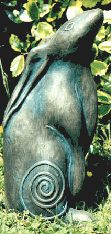
All the world will be your enemy,
prince with a thousand enemies,
and when they catch you they will kill you.
But first they must catch you, digger, runner,
prince with the swift warning.
Be cunning and full of tricks,
and your people will never be destroyed.
Richard Adams
Watership Down
prince with a thousand enemies,
and when they catch you they will kill you.
But first they must catch you, digger, runner,
prince with the swift warning.
Be cunning and full of tricks,
and your people will never be destroyed.
Richard Adams
Watership Down
Although the archetypal “prince” in Richard Adams’ classic novel Watership Down refers to the rabbit and not the hare, it’s a close enough fit for the focus of this blogsite to warrant inclusion, wouldn’t you say? Indeed, except for the fact that hares aren’t “diggers” of burrows, I’m sure you’d agree that Adams’ words are equally applicable to the hare as to the rabbit.
In case you’re unfamiliar with Watership Down, here’s how critic Paul Hughes describes the book’s plot: “The story follows a warren of Berkshire rabbits fleeing the destruction of their home by a land developer. As they search for a safe haven, skirting danger at every turn, we become acquainted with the band and its compelling culture and mythos. Adams has crafted a touching, involving world in the dirt and scrub of the English countryside, complete with its own folk history and language.”
The book’s title refers to a hill in the north of Hampshire, England, where the rabbits eventually find a new home.

Watership Down was Adams’ first and most successful novel. It was originally published in the United Kingdom in 1972 and since then has never been out of print. It has been made into a successful animated film and television series.
SparkNotes.com observes that in Watership Down, “Adams presents rabbits as intelligent, caring, feeling creatures who undergo many trials and misfortunes for the sole purpose of finding a home where they can leave out their lives. The book often carries a tone that suggests that humanity has lost something it used to have — the ability to live free, as the rabbits do. The notion that people should live as a part of nature rather than apart from nature is a strong undercurrent that flows through much of the work. Indeed, the novel’s popularity stems not just from the enjoyable story itself, but also from the societal implications that can easily be found in it. At times, Watership Down is almost pleading in tone, suggesting that we still have time to stop our destruction of animals’ homes before it is too late – an idea that appeals to many.
“Yet the novel is not simply a message about the way we should treat animals. It is also a story about life, as the novel’s depiction of the rabbits’ lives in their warrens raises many strong parallels to human societies. However Watership Down is read – as a political, social, or environmental critique or simply as a book about the search for a home and life – it is undoubtedly greatly influenced by the state of the natural world in the twentieth century and the role that humanity must play within that world.”

I read Watership Down as a teenager in the late 1970’s and identified with the book’s rag-tag band of characters and their struggle to find a place of safety within an often hostile world. I related their struggle to my own: I was, after all, a weedy teenager coming to terms with the realization that I was gay. I was particularly drawn to the character of Fiver (pictured above), the “runt of the litter,” yet also the prophetic voice of the community, the visionary.
As a closeted young gay person, I too felt as if I had a “thousand enemies,” though, in retrospect, I realize the greatest of these was my own fear. I feared the truth about myself, and what this truth meant for me and for my future.
It took many years to fully accept and love myself for who I am. Yet through this proactive, risk-taking, and often difficult journey of self-awareness, I came to both discover and create a new life – or perhaps, better still, my true life.
And it is in the light of this truth that I am able to walk upon the sacred ground of my own Watership Down.
Image 1: European or Brown Hare by Martin McGill of WWT.
Image 2: “Visiting Watership Down” by Jeanette Peters.
Image 3: Fiver, runt and seer, as depicted in the animated film adaptation of Watership Down.
Recommended Off-site Link:
Bunnies in Jeopardy: Watership Down, an Unsung Animated Classic by Daniel Kraus.



















No comments:
Post a Comment